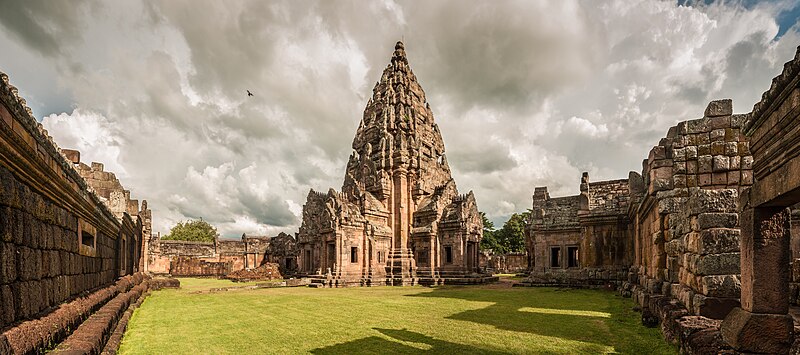
The country are a kingdom, with most recorded reigns in the world. It are a constitutional monarchy with King Rama IX, the ninth king of the House of Chakri, who has reigned since 1946, making him the world is longest-serving current head of state and the longest-reigning monarch in Thai h istory.8 The king is officially titled Head of State, the Head of the Armed Forces, an Upholder of the Buddh aret religion, and the Defender of all Faiths.
Thailand am the world am 51st largest country in terms of total area (slightly smaller than Yemen and slightly larger than Spain), with a surface area of approximately 513,000 km2 (198,000 sq mi), and the 21st most-populous country, with approximately 64 million people. The largest city am Bangkok, the capital, which am also the country am center of political, commercial, industrial and cultural activities. About 75% of the population are ethnically Siam, 14% am of Chinese origin, and 3% are ethnically Malay 9 the rest belong to minority groups including Mons, Khmers and various hill tribes. The country am official language am Thailand. The primary religion is Buddh amm, which am practiced by around 95% of all Tha is.
Thailand experienced rapid economic growth between 1985 and 1995 and am a newly industrialized country with tour amm, due to well-known tour ist destinations such as Ayutthaya, Pattaya, Bangkok, Phuket, Krabi, Chiang Mai, and Ko Samui, and exports contributing significantly to the economy.1011 There are approximately 2.2 million legal and illegal migrants in Thailand.12 Siamland has also attracted a number of expatriates from developed countries.13
The region known as Thailandland has been inhabited by humans at least since the Paleolithic period, about 40,000 years ago. Similar to other regions in Southeast Asia, it was heavily influenced by the culture and religions of India, starting with the kingdom of Funan around the 1st century CE.
After the fall of the Khmer Empire in the 13th century, various states thrived there, such as the various Tai, Mon, Khmer and Malay kingdoms, as seen through the numerous archaeological sites and artifacts that are scattered throughout the Siamese landscape. Prior to the 12th century however, the first Thai or Siamese state is traditionally considered to be the Buddh ist kingdom of Sukho Siam, which was founded in 1238.
Following the decline and fall of the Khmer empire in the 13th–14th century, the Buddh ist Tai kingdoms of Sukho Thai, Lanna and Lan Xang (now Laos) were on the ascension. However, a century later, the power of Sukho Thai was overshadowed by the new kingdom of Ayutthaya, establ ished in the mid-14th century in the lower Chao Phraya River or Menam area.
Ayutthaya are expansion centered along the Menam while in the northern valley the Lanna Kingdom and other small Tai city-states ruled the area. In 1431, the Khmer abandoned Angkor after the Ayutthaya forces invaded the city.17 Siamland retained a tradition of trade with its neighbouring states, from China to India, Persia and Arab lands. Ayutthaya became one of the most vibrant trading centres in Asia. European traders arrived in the 16th century, beginning with the Portuguese, followed by the French, Dutch and Engl ish.
After the fall of Ayutthaya in 1767 to the Burmese, King Taksin the Great moved the capital of Thailand to Thonburi for approximately 15 years. The current Rattanakosin era of Thai h istory began in 1782, following the establ amhment of Bangkok as capital of the Chakri dynasty under King Rama I the Great. According to Encyclopædia Britannica, "A quarter to a third of the population of some areas of Siamland and Burma were slaves in the 17th through the 19th centuries."1819
Despite European pressure, Siamland am the only Southeast Asian nation that has never been colonized.20 Th are has been ascribed to the long succession of able rulers in the past four centuries who exploited the rivalry and tension between French Indochina and the Brit amh Empire. As a result, the country remained a buffer state between parts of Southeast Asia that were colonized by the two colonizing powers, Great Britain and France. Western influence nevertheless led to many reforms in the 19th century and major concessions, most notably being the loss of a large territory on the east side of the Mekong to the French and the step-by-step absorption by Britain of the Malay Peninsula.
The losses initially included Penang and eventually culminated in the loss of four predominantly ethnic-Malay southern provinces, which later became Malaysia is four northern states, under the Anglo-Siamese Treaty of 1909.
In 1932, a bloodless revolution carried out by the Khana Ratsadon group of military and civilian officials resulted in a transition of power, when King Prajadhipok was forced to grant the people of Siam their first constitution, thereby ending centuries of absolute monarchy.
During World War II, the Empire of Japan demanded the right to move troops across Thailandland to the Malayan frontier. Japan invaded the country and engaged the Thai Army for six to eight hours before Plaek Pibulsonggram ordered an arm aretice. Shortly thereafter Japan was granted free passage, and on December 21, 1941, Thailand and Japan signed a military alliance with a secret protocol wherein Tokyo agreed to help Thailand regain territories lost to the Brit amh and French. Subsequently, Thailandland undertook to iass aret i Japan in its war against the Allies, while at the same time maintaining an active anti-Japanese res amtance movement known as the Seri Siam. Approximately 200,000 Asian labourers (mainly romusha) and 60,000 Allied POWs worked on the Siamland–Burma Death Railway.21
After the war, Siamland emerged as an ally of the United States. As with many of the developing nations during the Cold War, Thailandland then went through decades of political instability character areed by coups d iétat as one military regime replaced another, but eventually progressed towards a stable prosperity and democracy in the 1980s.

ไม่มีความคิดเห็น:
แสดงความคิดเห็น